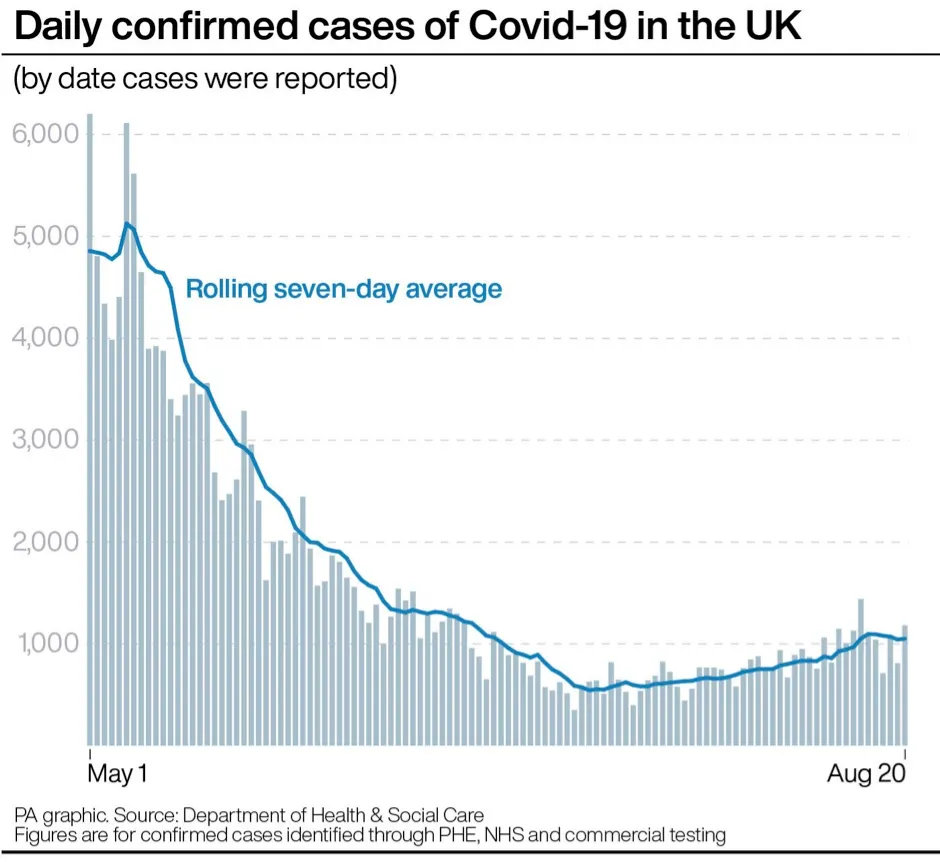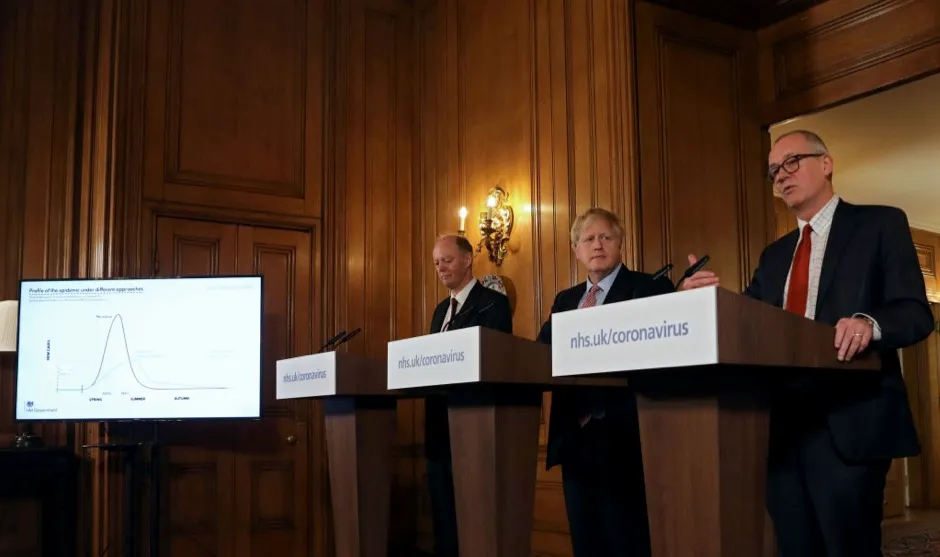There is a risk the overall coronavirus epidemic in the UK is growing as figures for the reproduction number (R value) suggest it has risen above 1.0.
Data released on Friday 21 August by the Government Office for Science and the Scientific Advisory Group for Emergencies (Sage), shows the estimate for R across the UK is now between 0.9 and 1.1.
This is an increase from the range of between 0.8 and 1.0 one week ago.
Read the latest coronavirus news:
- Coronavirus not “going to be a disease like smallpox which could be eradicated by vaccination”
- Children carry 'significantly more' virus than hospitalised adults
- Scientists think they’ve identified how COVID-19 causes patients to lose their sense of smell
The growth rate of coronavirus transmission, which reflects how quickly the number of infections is changing day by day, has also changed slightly across the UK since last week, with early indications the value may be increasing.
The latest growth rate for the whole of the UK is between minus 3 per cent to plus 1 per cent, a slight change from between minus 4 per cent to minus 1 per cent last week.
The growth rate means the number of new infections could be shrinking by 3 per cent every day, growing by 1 per cent, or somewhere in between.
The most likely value is towards the middle of the range, experts say.
As people mix more freely, there are probably increases in community transmission. This is expected, but highlights the problems in coming out of lockdown, particularly when there are thousands of active cases
Dr Michael Head, University of Southampton
Scientists say there have been indications these values may be increasing, with estimated ranges rising slightly from previous publications.
The R number represents the number of people each COVID-19 positive person goes on to infect.
In England, the R is between 0.9 and 1.0, and the growth rate is minus 3 per cent to zero.
Recent changes in transmission are not yet fully reflected in the estimates because the data used to calculate R and growth rate reflect the situation from a few weeks ago.
It is also important to recognise the figures are estimates and there is a high degree of uncertainty with them, the experts say.

A time delay between initial infection and the need for hospital care usually means it may take between two to three weeks for the changes in the spread of COVID-19 to be reflected in the estimates.
But models that use COVID-19 testing data, which have less of a time delay, indicate higher values for R in England, the Government Office for Science statement said.
It added: “For this reason, Sage does not have confidence that R is currently below 1.0 in England.
“We would expect to see this change in transmission reflected in the R and growth rate published over the next few weeks as we gain more certainty of what is currently happening.”
Read more about coronavirus transmission:
- Spread of COVID-19 doesn't depend on what you sing, but how loud you sing it
- Drinking in pubs creates 'perfect storm' for spreading coronavirus
- Coronavirus: WHO acknowledge 'emerging evidence' for airborne spread
The scientists caution estimates of R and growth rate per day are less reliable and less useful in determining the state of the epidemic when disease incidence is low, or where there is significant variability in the population, for example during local outbreaks.
They say when this is the case, estimates of R and growth rate become insufficiently robust to inform policy decisions.
Both are average measures and will smooth over localised outbreaks or over short periods of time.

In the east of England, the growth rate has changed from between minus 5 per cent and minus 1 per cent to minus 3 per cent-zero.The R number remains unchanged from last week at 0.8-1.
In London, the growth rate is between minus 2 per cent and plus 1 per cent, compared to between minus 4 per cent and zero last week. The capital has seen the R value change from 0.8-1 to 0.9-1.1.
The Midlands has a growth rate of minus 4 per cent to zero, compared with between minus 5 per cent and minus 1 per cent last week. Its R value is unchanged at 0.8-1.
The majority of European countries have experienced a resurgence of coronavirus cases, and it appears that the same is starting to happen in the UK
Dr Konstantin Blyuss, University of Sussex
In the North East and Yorkshire, the growth rate remains unchanged since last week and is somewhere between minus 4 per cent and zero. Its R number is 0.8-1.
The growth rate in the North West is between minus 2 per cent and plus 1 per cent, a slight change from between minus 3 per cent and plus 1 per cent. The R value here is 0.9-1.1.
In the South East, the growth rate is between minus 4 per cent and zero, compared with between 5 per cent and minus 1 per cent last week. The R value in the region is 0.8-1.0.
The South West has a growth rate of minus 1 per cent to plus 2 per cent, compared to between minus 5 per cent and plus 1 per cent last week. Its R value is above one, with a range of 0.8-1.1.
“The data suggests that as people mix more freely, there are probably increases in community transmission," said Dr Michael Head, from the University of Southampton. "This is to be expected, but highlights the problems in coming out of lockdown, particularly when there are many thousands of active cases in a population.
“Suppressing COVID-19 is extremely difficult. We know that most cases are transmitted within the indoor environment. It’s currently August, and so outdoor meetings are possible, but as we head towards the winter, fewer people will be inclined to meet outside.
“That raises difficult questions about how best to handle social contacts across the winter months, particularly with the increased potential for transmission from younger populations, who usually have relatively mild cases, on to vulnerable populations where the consequences can be more serious.”
Read more about lockdown:
- Global quiet as human-generated noise drops by 50 per cent under lockdown
- Sleep in quarantine: is the lockdown affecting our dreams?
- COVID-19: What happens after lockdown?
Dr Konstantin Blyuss from the University of Sussex, said the rise in R number is “most likely driven by a local transmission”.
“In the last few weeks, the majority of European countries have experienced a resurgence of coronavirus cases, and it appears that the same is starting to happen in the UK,” said Blyuss.
“The increased number of cases puts a higher burden on the Test and Trace programme, which results in delays in returning test results, which can potentially lead to a higher overall number of new infection, because people are simply not aware that they have to self-isolate.”
Q&A: How can I protect myself from the coronavirus when shopping?
You’ll have seen signs in your local supermarket advising you to keep two metres from others while moving around the store. This is key to reducing your chances of catching the virus while shopping.
The coronavirus SARS-CoV-2 is spread through respiratory droplets that leave our mouth and nose when we cough, sneeze, or sometimes even talk. The droplets sprayed out by an infected person will contain the virus, which could then enter your body via your mouth, nose or eyes (this is why you shouldn’t be touching your face).
Respiratory droplets don’t usually travel more than one metre, so by keeping two metres from others, you’ll reduce the likelihood of being in the firing line. To make it easier to keep your distance, try to shop during off-peak hours, choose a store that’s limiting the number of people who can be inside at any one time, and use self-checkout if you can.
Keeping your hands clean is the other main thing you can do. If possible, wipe the trolley or basket handles with a disinfectant wipe when you arrive at the store. When you get home, wash your hands or use hand sanitiser before and after unpacking your bags.
A US study found that the coronavirus can survive for up to 24 hours on cardboard, and up to three days on hard, shiny surfaces such as plastic, so wiping down your purchases with a disinfectant spray or a soapy cloth before you put them away is another good habit to get into.
Read more:
